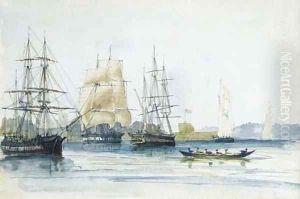Owen Stanley Paintings
Owen Stanley was a British naval officer, surveyor, and cartographer, rather than a traditional artist in the sense of painting or sculpture. Born in Alderley, England, on June 13, 1811, he was the second son of Edward Stanley, the Bishop of Norwich, and Catherine Leycester. His family was well-connected and intellectual, which provided him with a privileged upbringing and education.
Owen Stanley joined the Royal Navy in 1826, embarking on a career that would see him involved in various surveying missions. His work was crucial in charting many areas of the Pacific and Australian waters that were poorly known at the time. Stanley's skills as a surveyor and his contributions to cartography were his artistic legacy, creating maps and charts that were both functional and of a high technical standard.
One of his notable voyages was aboard the HMS Adventure and the HMS Beagle, the latter being famous for carrying Charles Darwin on his legendary expedition. Stanley, however, served on these ships during their surveying missions before Darwin's journey. He was promoted to the rank of commander in 1841 and given command of the HMS Britomart, with which he surveyed parts of the Australian coast.
In 1846, Stanley was appointed to command the HMS Rattlesnake on a four-year surveying voyage in the Pacific, during which extensive work was done on the coastlines of Australia and New Guinea. Tragically, his career was cut short when he died of fever in March 1850 in Sydney, at the age of 38. His death was a significant loss to the field of naval surveying.
Although not an 'artist' in the traditional sense, Owen Stanley's charts and maps served as vital tools for navigation and had an aesthetic quality appreciated by those who understood the intricacies of cartographic representation. His work helped to open up new frontiers for exploration and commerce, and his contributions to naval surveying remain his enduring legacy.
